Analyzing Gaps in Hurricane Rain Coverage to Inform Future Satellite Proposals
Abstract
1. Introduction
2. Background
2.1. The Tropical Cyclone Environment
2.2. Proposed Satellites
3. Data and Methodology
3.1. NOAA Airborne Radars
3.1.1. NOAA WP-3D Lower Fuselage Radar
3.1.2. NOAA WP-3D Tail Doppler Radar
3.2. Estimating Rain Rates from NOAA Radar Backscatter
3.3. Rain-Free Footprint Application
4. Results
5. Discussion
6. Conclusions
Author Contributions
Funding
Acknowledgments
Conflicts of Interest
References
- Marks, F.D. Evolution of the Structure of Precipitation in Hurricane Allen (1980). Mon. Weather Rev. 1985, 113, 909–930. [Google Scholar] [CrossRef]
- Stephens, G.L.; Kummerow, C.D. The Remote Sensing of Clouds and Precipitation from Space: A Review. J. Atmos. Sci. 2007, 64, 3742–3765. [Google Scholar] [CrossRef]
- Holbach, H.M.; Uhlhorn, E.W.; Bourassa, M.A. Off-Nadir SFMR Brightness Temperature Measurements in High-Wind Conditions. J. Atmos. Ocean. Technol. 2018, 35, 1865–1879. [Google Scholar] [CrossRef]
- Lauknes, T.R. Rockslide Mapping in Norway by Means of Interferometric SAR Time Series Analysis. Ph.D. Thesis, University of Tromsø, Munin, Iceland, 18 March 2011. [Google Scholar]
- Bourassa, M.A.; Meissner, T.; Cerovecki, I.; Chang, P.S.; Dong, X.; De Chiara, G.; Donlon, C.; Dukhovskoy, D.S.; Elya, J.; Fore, A.; et al. Remotely Sensed Winds and Wind Stresses for Marine Forecasting and Ocean Modeling. Front. Mar. Sci. 2019, 6, 443. [Google Scholar] [CrossRef]
- Rodriguez, E.; Bourassa, M.A.; Chelton, D.; Farrar, J.T.; Long, D.; Perkovic-Martin, D.; Samelson, R. The Winds and Currents Mission Concept. Front. Mar. Sci. 2019, 6, 438. [Google Scholar] [CrossRef]
- National Academies of Sciences, Engineering, and Medicine. Thriving on Our Changing Planet: A Decadal Strategy for Earth Observation from Space; The National Academies Press: Washington, DC, USA, 20 January 2019. [Google Scholar]
- Barnes, C.E.; Barnes, G.M. Eye and Eyewall Traits as Determined with the NOAA WP-3D Lower-Fuselage Radar. Mon. Weather Rev. 2014, 142, 3393–3417. [Google Scholar] [CrossRef]
- Willoughby, H.E.; Clos, J.A.; Shoreibah, M.G. Concentric Eye Walls, Secondary Wind Maxima, and The Evolution of the Hurricane vortex. J. Atmos. Sci. 1982, 39, 395–411. [Google Scholar] [CrossRef]
- Senn, H.V.; Hiser, H.W. On the Origin of Hurricane Spiral Rainbands. J. Meteorol. 1959, 16, 419–426. [Google Scholar] [CrossRef][Green Version]
- Kepert, J.D. The Boundary Layer Dynamics of Tropical Cyclone Rainbands. J. Atmos. Sci. 2018, 75, 3777–3795. [Google Scholar] [CrossRef]
- Barnes, G.M.; Zipser, E.J.; Jorgensen, D.; Marks, F., Jr. Mesoscale and Convective Structure of a Hurricane Rainband. J. Atmos. Sci. 1983, 40, 2125–2137. [Google Scholar] [CrossRef]
- Barnes, G.M.; Stossmeister, G.J. The Structure and Decay of a Rainband in Hurricane Irene (1981). Mon. Weather Rev. 1986, 114, 2590–2601. [Google Scholar] [CrossRef]
- Chelton, D.B.; Schlax, M.G.; Samelson, R.M.; Farrar, J.T.; Molemaker, M.J.; McWilliams, J.C.; Gula, J. Prospects for future satellite estimation of small-scale variability of ocean surface velocity and vorticity. Prog. Oceanogr. 2018, 173, 256–350. [Google Scholar] [CrossRef]
- Ardhuin, F.; Brandt, P.; Gaultier, L.; Donlon, C.; Battaglia, A.; Boy, F.; Casal, T.; Chapron, B.; Collard, F.; Cravatte, S.; et al. SKIM, a Candidate Satellite Mission Exploring Global Ocean Currents and Waves. Front. Mar. Sci. 2019, 6, 209. [Google Scholar] [CrossRef]
- Draper, D.W.; Long, D. Evaluating the effect of rain on SeaWinds scatterometer measurements. J. Geophys. Res. Space Phys. 2004, 109, 1–12. [Google Scholar] [CrossRef]
- Jorgensen, D.; Willis, P. A Z-R relationship for hurricanes. J. Appl. Meteorol. 1982, 21, 356–366. [Google Scholar] [CrossRef]
- Radar Lower Fuselage Sweep Format. Available online: https://www.aoml.noaa.gov/hrd/format/lfsweepfileformat.html (accessed on 21 March 2020).
- Reasor, P.D.; Montgomery, M.T.; Marks, F.D.; Gamache, J.F. Low-Wavenumber Structure and Evolution of the Hurricane Inner Core Observed by Airborne Dual-Doppler. Mon. Weather Rev. 2014, 128, 1653–1680. [Google Scholar] [CrossRef]
- Irma 2017 Radar Data. Available online: https://www.aoml.noaa.gov/hrd/Storm_pages/irma2017/radar.html (accessed on 29 March 2020).
- Awaka, J.; Le, M.; Chandrasekar, V.; Yoshida, N.; Higashiuwatoko, T.; Kubota, T.; Iguchi, T. Rain Type Classification Algorithm Module for GPM Dual-Frequency Precipitation Radar. J. Atmos. Ocean. Technol. 2016, 33, 1887–1898. [Google Scholar] [CrossRef]
- Jiang, H.; Black, P.G.; Zipser, E.J.; Marks, F.D.; Uhlhorn, E.W. Validation of rain-rate estimation in hurricanes from the stepped frequency microwave radiowave: Algorithm correct and error analysis. J. Atmos. Sci. 2006, 63, 252–267. [Google Scholar] [CrossRef]
- Marshall, J.S.; Langille, R.C.; Palmer, W.M.K. Measurement of rainfall by radar. J. Meteorol. 1947, 4, 186–192. [Google Scholar] [CrossRef]
- Wexler, R.; Atlas, D. Radar reflectivity and attenuation of rain. J. Appl. Meteorol. 1963, 2, 276–280. [Google Scholar] [CrossRef]
- Olsen, R.; Rogers, D.; Hodge, D. The aRb relation in the calculation of rain attenuation. IEEE Trans. Antennas Propag. 1978, 26, 318–329. [Google Scholar] [CrossRef]
- Ulaby, F.; Long, D.G. Microwave Radar and Radiometric Remote Sensing, 1st ed.; University of Michigan Press: Ann Arbor, MI, USA, 2014; p. 1111. [Google Scholar]
- Battaglia, A.; Mroz, K.; Watters, D.; Ardhuin, F. GPM-Derived Climatology of Attenuation Due to Clouds and Precipitation at Ka-Band. IEEE Trans. Geosci. Remote Sens. 2020, 58, 1812–1820. [Google Scholar] [CrossRef]
- Ardhuin, F.; Chapron, B.; Maes, C. Satellite Doppler Observations for the Motions of the Oceans. Bull. Am. Meteorol. Soc. 2019, 100, ES215–ES219. [Google Scholar] [CrossRef]
- Powell, M.D.; Houston, S.H.; Amat, L.R. The HRD real-time hurricane wind analysis system. J. Wind. Eng. Ind. Aerodyn. 1998, 77, 53–64. [Google Scholar] [CrossRef]
- Remund, Q.P.; Long, D.G. A Decade of QuikSCAT Scatterometer Sea Ice Extent Data. IEEE Trans. Geosci. Remote Sens. 2014, 52, 4281–4290. [Google Scholar] [CrossRef]
- Bourassa, M.; McBeth-Ford, K. Uncertainty in scatterometer-derived vorticity. J. Atmos. Ocean. Technol. 2010, 27, 594–603. [Google Scholar] [CrossRef][Green Version]
- Rodriguez, E. On the optimal design of Doppler scatterometers. Remote Sens. 2018, 10, 1765. [Google Scholar] [CrossRef]
- Uhlhorn, E.W.; Black, P.G. Verification of Remotely Sensed Sea Surface Winds in Hurricanes. J. Atmos. Ocean. Technol. 2003, 20, 99–116. [Google Scholar] [CrossRef]
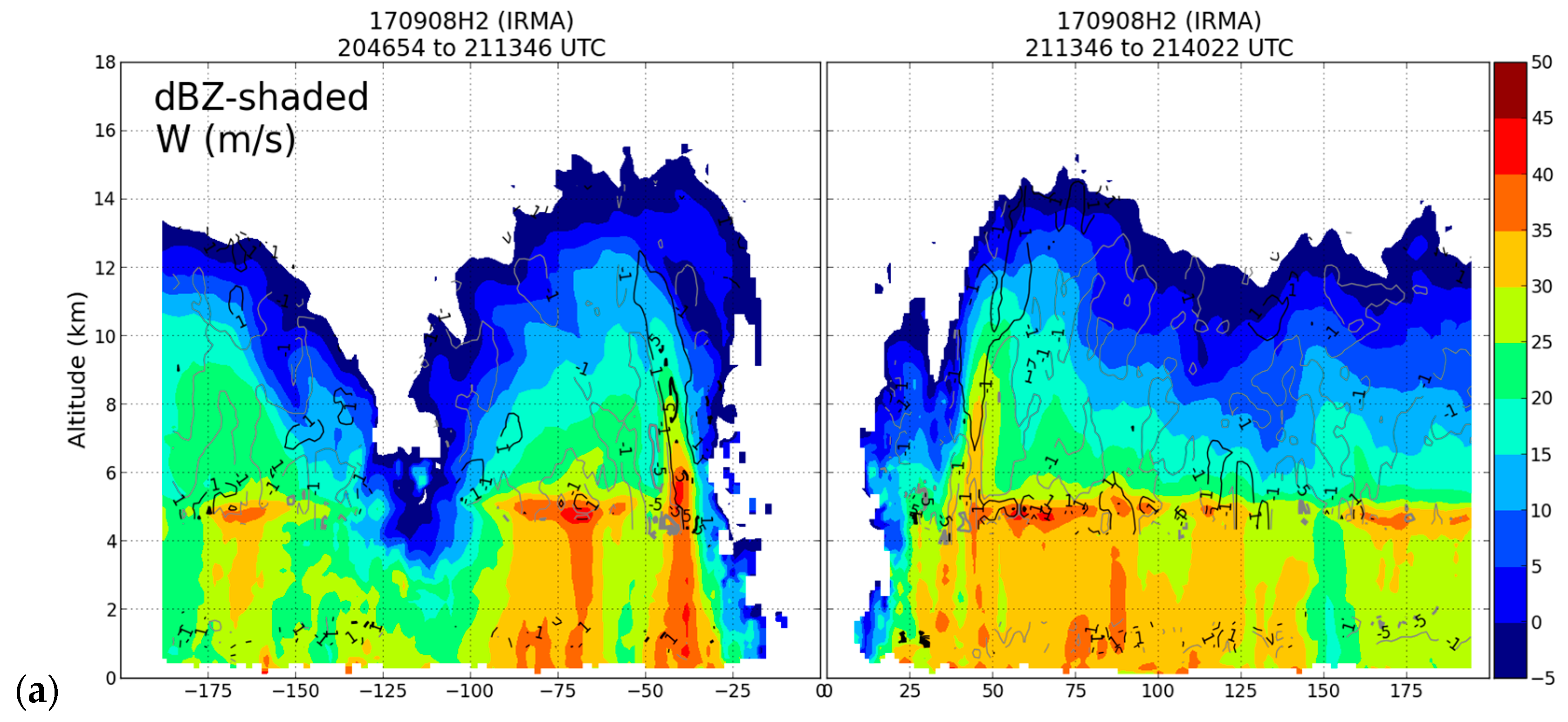

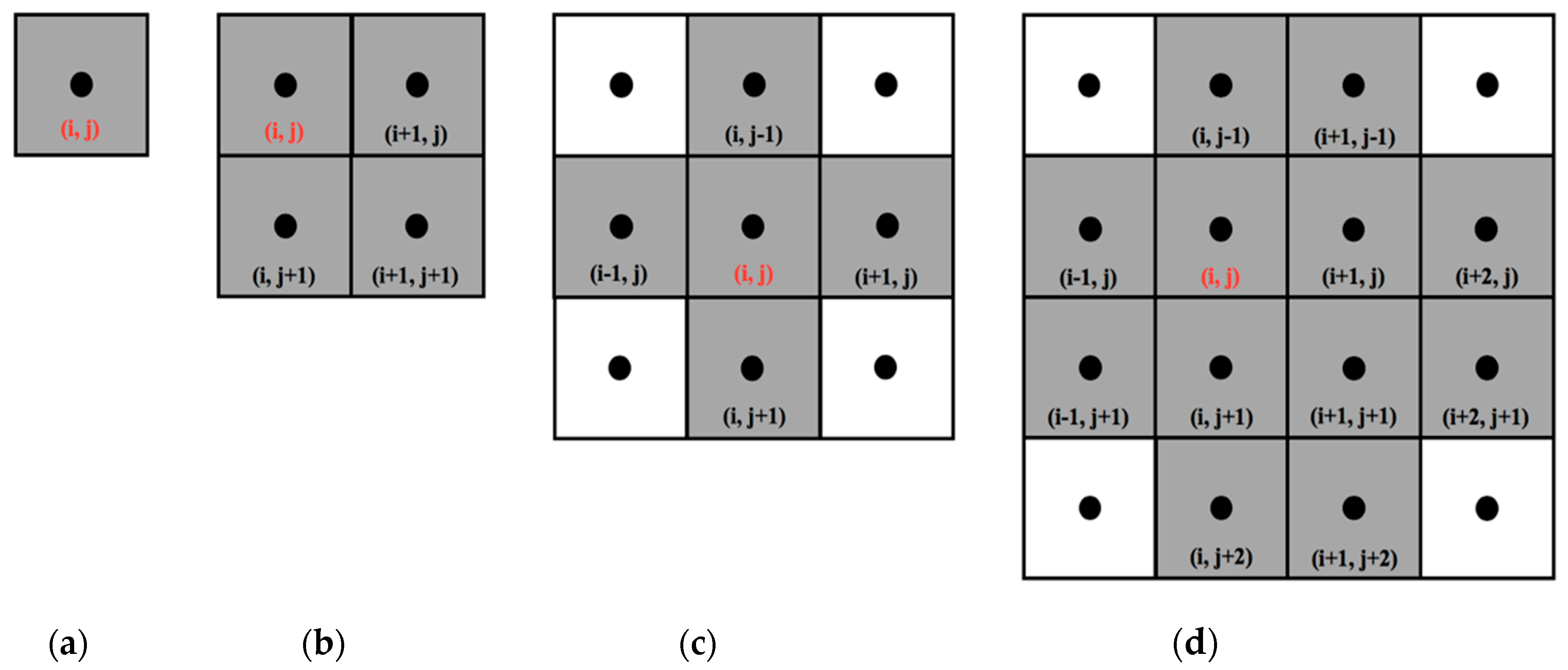


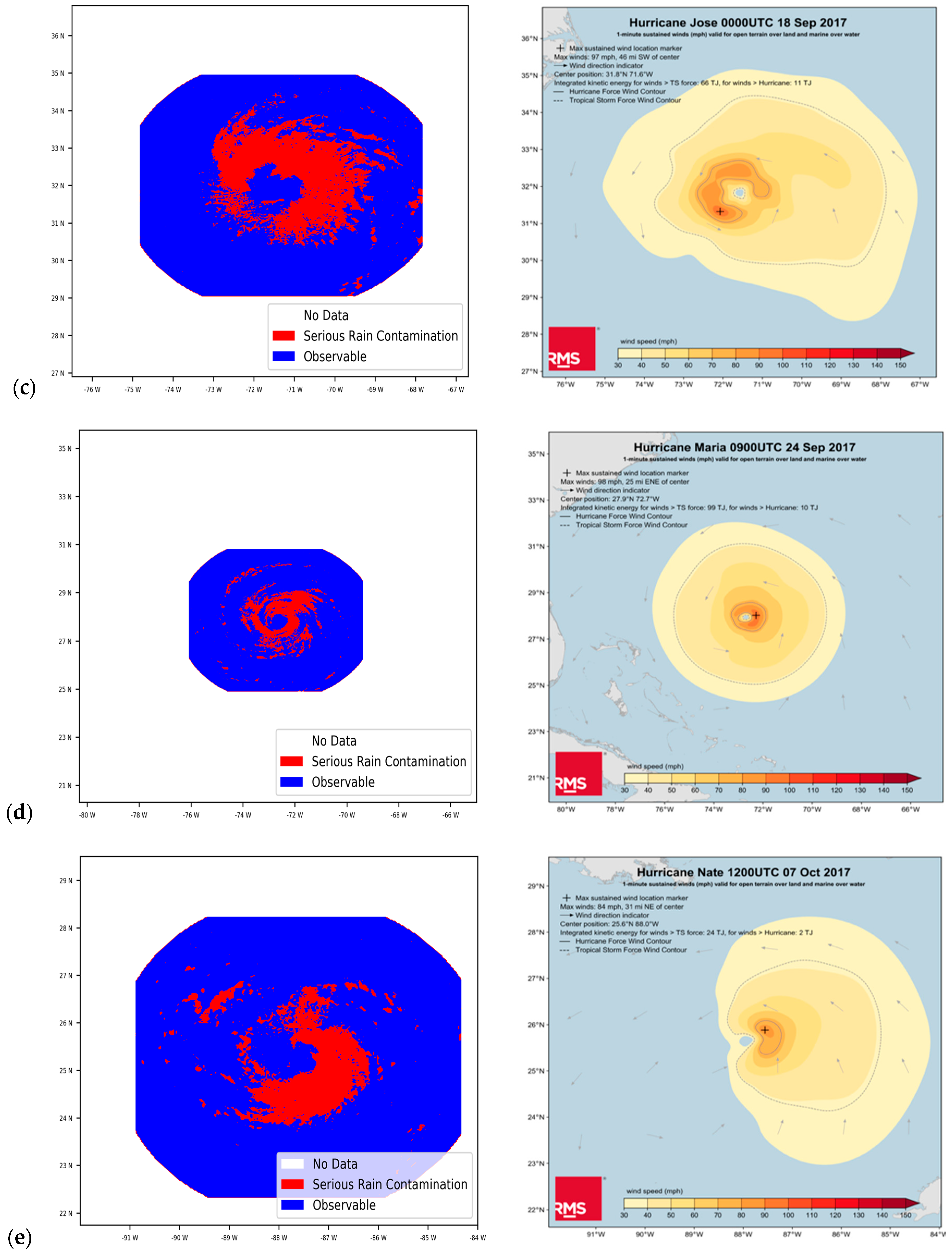
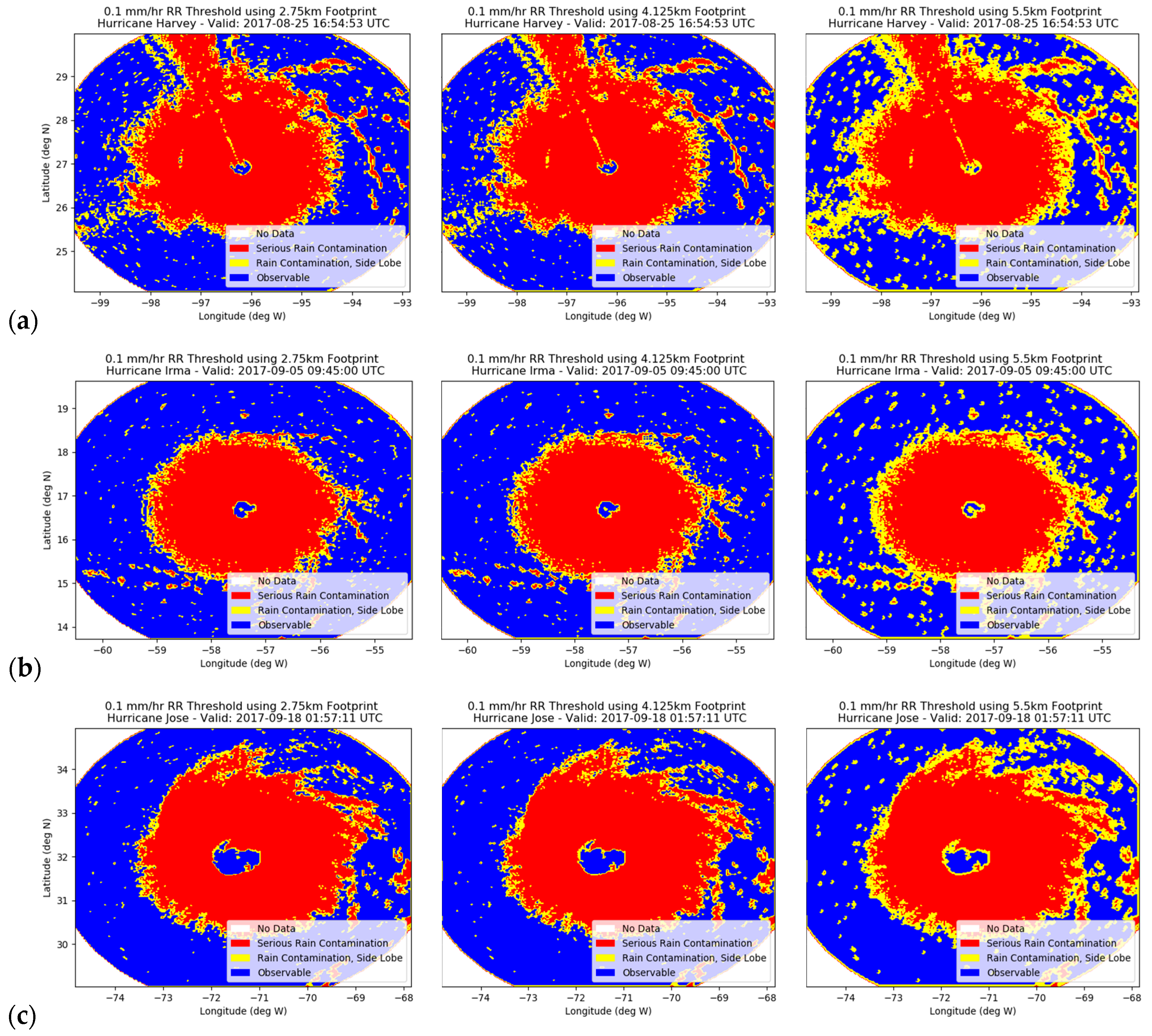
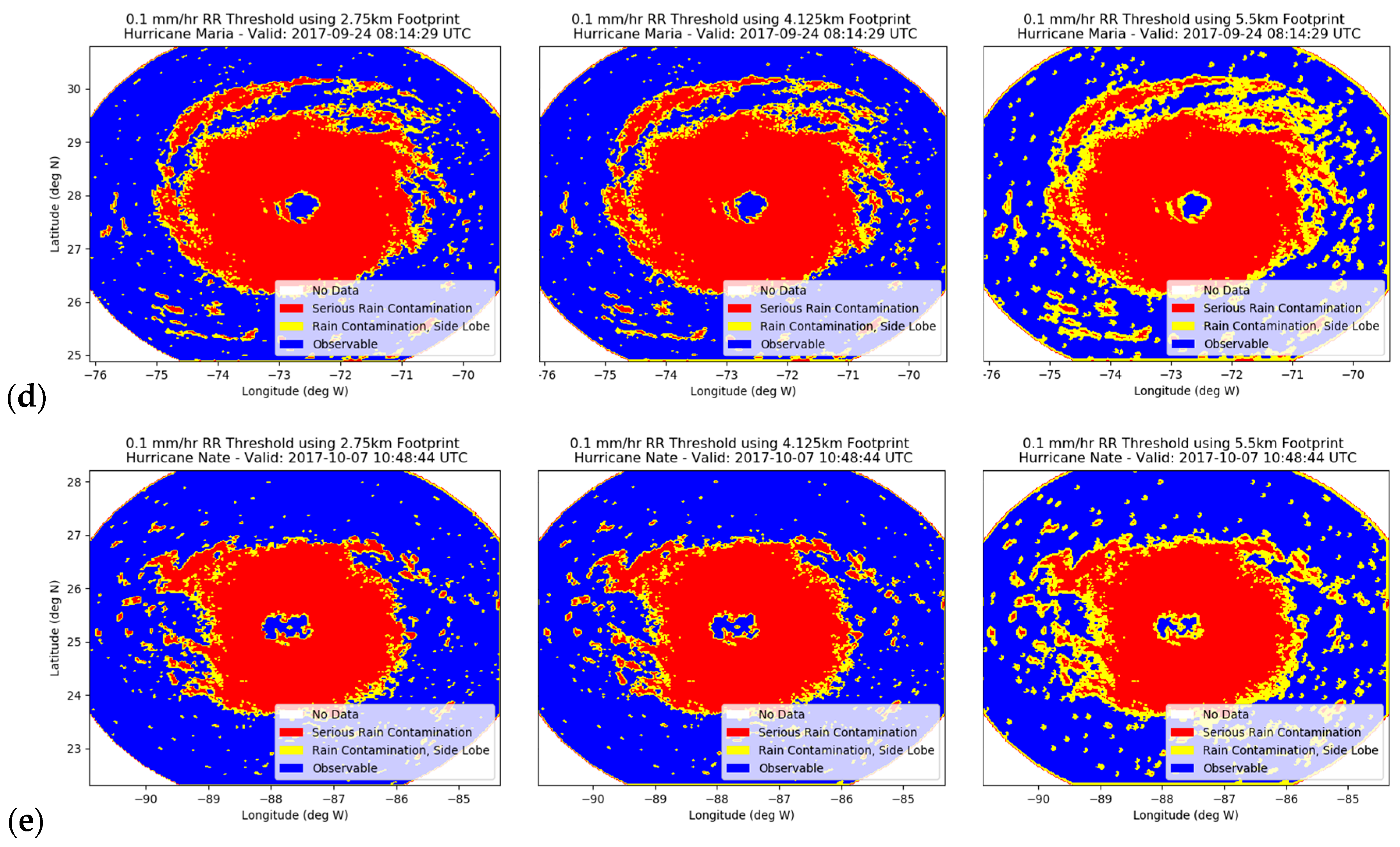
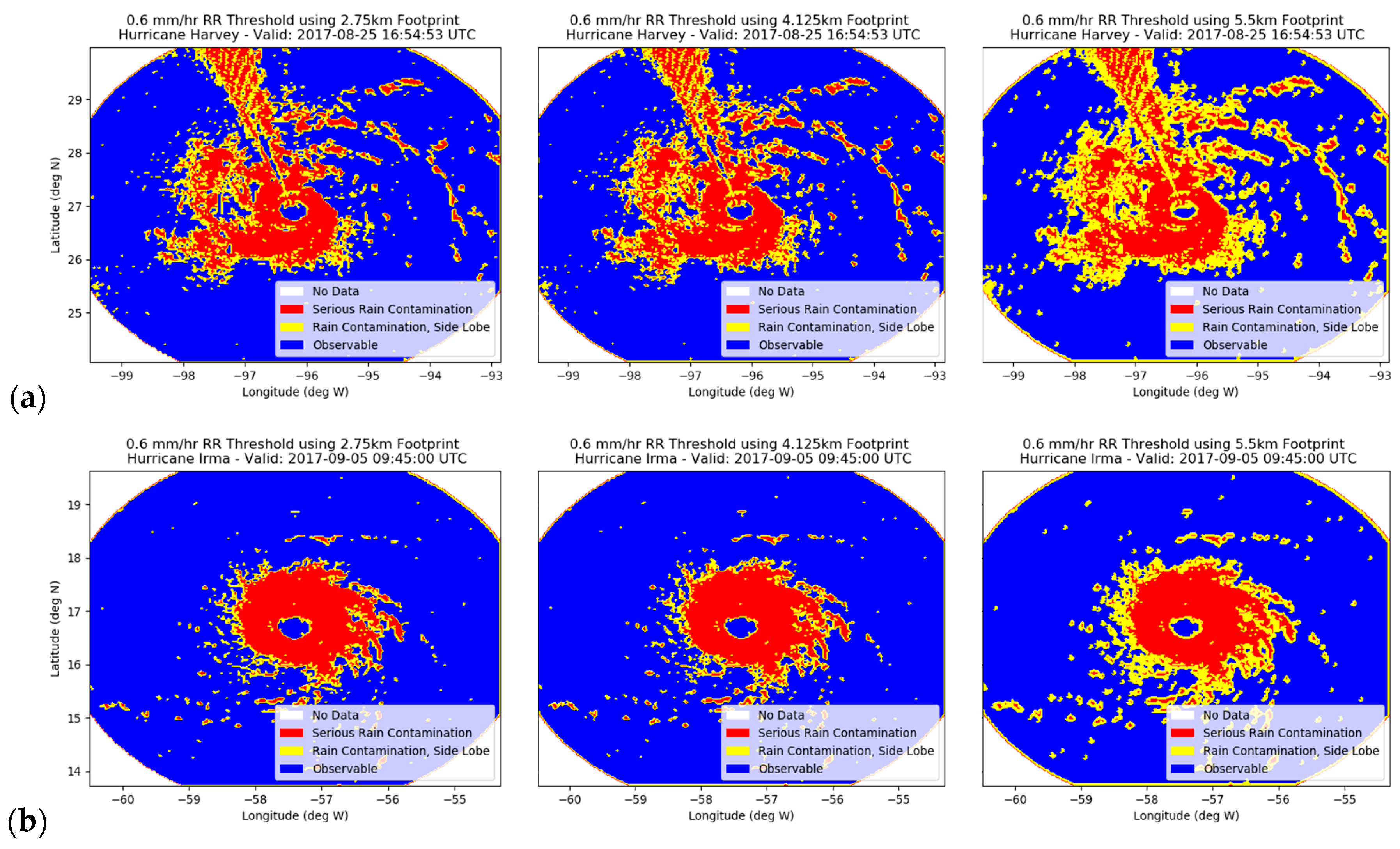
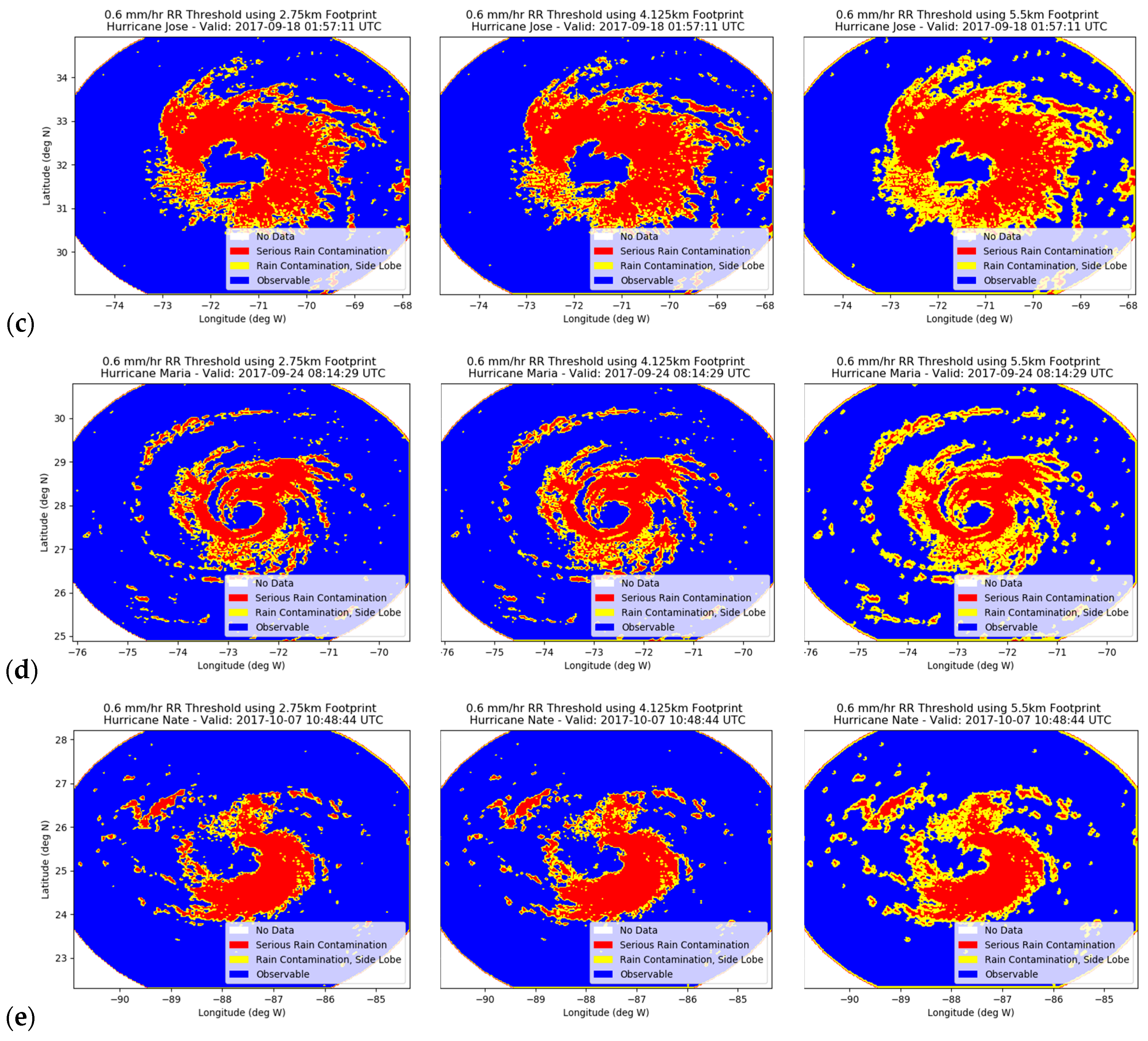

| Parameter | LF Radar | Tail Radar |
|---|---|---|
| Transmitter Frequency | 5370 ± 6.7 MHz | 9315 ± 11.6 MHz |
| Transmitter Wavelength | 5.59 cm | 3.22 cm |
| Transmitter Pulse | 6.0 μs | 0.5 μs |
| PRF | 200 PPS | 1600 PPS |
| Peak Transmitter Power | 70 kW (min) | 60 kW (min) |
| Receiver Dynamic Range | 80 dB | 80 dB |
| Gain (Main Beam) | 37.5 dB | 40 dB |
| Gain (Sidelobe) | 23 dB down | 23 dB down |
| Horizontal Beam Width | 1.1° | 1.35° |
| Vertical Beam Width | 4.1° | 1.9° |
| Antenna Stabilization | ±10° (pitch and roll) | ±25° (pitch and roll) |
| Maximum Range | 371 km | 93 km |
| Storm | Ka-Band (%) | Ku-Band (%) | C-Band (%) |
|---|---|---|---|
| Harvey | 38.581414 | 16.802261 | 0.162331 |
| Irma | 29.070700 | 11.328826 | 0.196707 |
| Jose | 38.411000 | 22.161955 | 0.003819 |
| Maria | 34.110363 | 13.342632 | 0.017196 |
| Nate | 27.912528 | 12.463712 | 0.042016 |
| Storm | Ka-Band (%) | Ku-Band (%) | C-Band (%) |
|---|---|---|---|
| Harvey | 49.448073 | 26.607081 | 1.455253 |
| Irma | 36.929452 | 16.468049 | 1.388411 |
| Jose | 45.859434 | 29.893048 | 0.928189 |
| Maria | 42.825206 | 20.779195 | 0.970651 |
| Nate | 35.166157 | 17.910618 | 1.048510 |
| Storm | Ka-Band (%) | Ku-Band (%) | C-Band (%) |
|---|---|---|---|
| Harvey | 51.974714 | 28.971391 | 2.127497 |
| Irma | 39.058859 | 18.156296 | 2.033917 |
| Jose | 47.729182 | 31.860198 | 1.478227 |
| Maria | 45.089422 | 22.896285 | 1.534316 |
| Nate | 37.226890 | 19.619938 | 1.629106 |
| Storm | Ka-Band (%) | Ku-Band (%) | C-Band (%) |
|---|---|---|---|
| Harvey | 61.678316 | 37.254115 | 4.096482 |
| Irma | 47.387418 | 24.137733 | 3.697337 |
| Jose | 54.436592 | 38.294499 | 2.759740 |
| Maria | 53.691531 | 30.157062 | 2.875649 |
| Nate | 45.261650 | 25.412528 | 3.048128 |
© 2020 by the authors. Licensee MDPI, Basel, Switzerland. This article is an open access article distributed under the terms and conditions of the Creative Commons Attribution (CC BY) license (http://creativecommons.org/licenses/by/4.0/).
Share and Cite
Stow, J.P.; Bourassa, M.A.; Holbach, H.M. Analyzing Gaps in Hurricane Rain Coverage to Inform Future Satellite Proposals. Remote Sens. 2020, 12, 2673. https://doi.org/10.3390/rs12172673
Stow JP, Bourassa MA, Holbach HM. Analyzing Gaps in Hurricane Rain Coverage to Inform Future Satellite Proposals. Remote Sensing. 2020; 12(17):2673. https://doi.org/10.3390/rs12172673
Chicago/Turabian StyleStow, Justin P., Mark A. Bourassa, and Heather M. Holbach. 2020. "Analyzing Gaps in Hurricane Rain Coverage to Inform Future Satellite Proposals" Remote Sensing 12, no. 17: 2673. https://doi.org/10.3390/rs12172673
APA StyleStow, J. P., Bourassa, M. A., & Holbach, H. M. (2020). Analyzing Gaps in Hurricane Rain Coverage to Inform Future Satellite Proposals. Remote Sensing, 12(17), 2673. https://doi.org/10.3390/rs12172673





